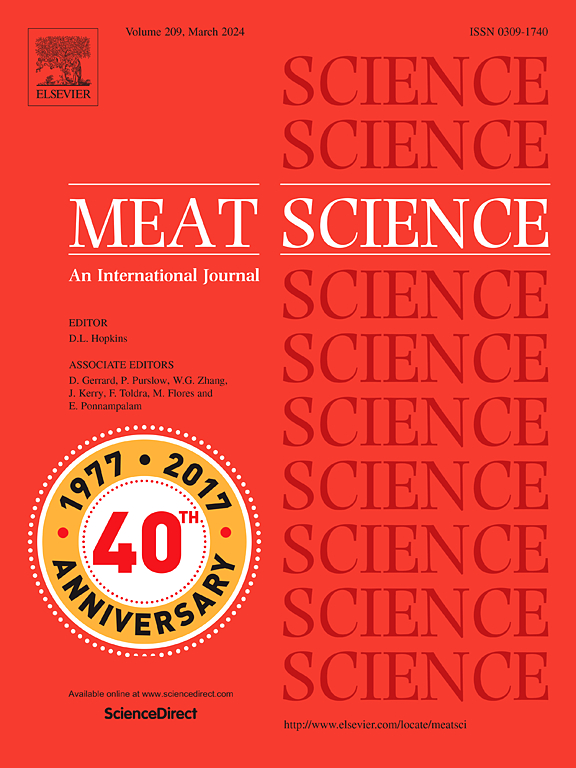微粉橄榄渣:一个可持续和创新的策略,以提高氧化稳定性的omega-3浓缩香肠
IF 7.1
1区 农林科学
Q1 Agricultural and Biological Sciences
引用次数: 0
摘要
本研究探索了微粉橄榄渣(MOP)在提高富含omega-3的意大利腊肠的氧化稳定性方面的潜力,同时也对其技术、微生物学和营养特性进行了全面的研究。制备了含有不同MOP浓度(0%、5%、10%和15%)的亚麻籽油凝胶,用于替代意大利腊肠中30%的动物脂肪,最终得到的MOP浓度分别为0% (MOP0%)、0.3% (MOP0.3%)、0.6% (MOP0.6%)和0.9% (MOP0.9%)。脂质重组对腊肠的成熟没有负面影响。与脂肪含量为30.7%的对照组相比,重新配方治疗的脂肪含量减少了6.8%至8.1%,而重新配方治疗的脂肪含量在28.2%至28.6%之间。α -亚麻酸含量从0.28 g/100 g增加到1.61 ~ 2.23 g/100 g。MOP显著减轻了由n-3 PUFAs引起的脂质氧化的增加,特别是在MOP0.9%处理中,与MOP0%样品相比,TBARS值降低了48%,而在储存90天后,与对照组相比,TBARS值仅增加了12%。这种处理表明,从碳水化合物发酵和氨基酸分解代谢中明显存在有益的挥发性化合物。在储存期间,它也表现出最高的颜色稳定性,最低的ΔE值证明了这一点。因此,本研究证明了MOP作为一种创新成分的潜力,可以增强富含n-3 PUFAs的肉制品的氧化稳定性,响应肉类行业对更健康、更可持续食品的关键需求。本文章由计算机程序翻译,如有差异,请以英文原文为准。
Micronized olive pomace: A sustainable and innovative strategy to improve the oxidative stability of omega-3 enriched salamis
This study explored the potential of Micronized Olive Pomace (MOP) to improve the oxidative stability of omega-3-enriched salamis while also offering a thorough examination of their technological, microbiological, and nutritional properties. Linseed oil gels containing different concentrations of MOP (0 %, 5 %, 10 %, and 15 %) were prepared and used to replace 30 % of the animal fat in salami, resulting in final MOP concentrations of 0 % (MOP0%), 0.3 % (MOP0.3%), 0.6 % (MOP0.6%), and 0.9 % (MOP0.9%) in the meat mass. The lipid reformulation did not negatively affect the salami ripening. The fat content of the reformulated treatments was reduced by 6.8 % to 8.1 %, compared to the control, which had 30.7 % fat, while the reformulated treatments contained between 28.2 % and 28.6 % fat. Additionally, the levels of alpha-linolenic acid increased from 0.28 to 1.61–2.23 g/100 g of sample. MOP significantly mitigated the increase in lipid oxidation caused by the inclusion of n-3 PUFAs, particularly in the MOP0.9% treatment, which showed a 48 % reduction in TBARS values compared to the MOP0% sample and only a 12 % increase compared to the control after 90 days of storage. This treatment showed a pronounced presence of beneficial volatile compounds from carbohydrate fermentation and amino acid catabolism. It also demonstrated the highest color stability during storage, evidenced by the lowest ΔE values. Thus, this study demonstrated the potential of MOP as an innovative ingredient to enhance the oxidative stability of meat products enriched with n-3 PUFAs, responding to a critical demand in the meat industry for healthier and more sustainable foods.
求助全文
通过发布文献求助,成功后即可免费获取论文全文。
去求助
来源期刊

Meat Science
工程技术-食品科技
CiteScore
12.60
自引率
9.90%
发文量
282
审稿时长
60 days
期刊介绍:
The aim of Meat Science is to serve as a suitable platform for the dissemination of interdisciplinary and international knowledge on all factors influencing the properties of meat. While the journal primarily focuses on the flesh of mammals, contributions related to poultry will be considered if they enhance the overall understanding of the relationship between muscle nature and meat quality post mortem. Additionally, papers on large birds (e.g., emus, ostriches) as well as wild-captured mammals and crocodiles will be welcomed.
 求助内容:
求助内容: 应助结果提醒方式:
应助结果提醒方式:


